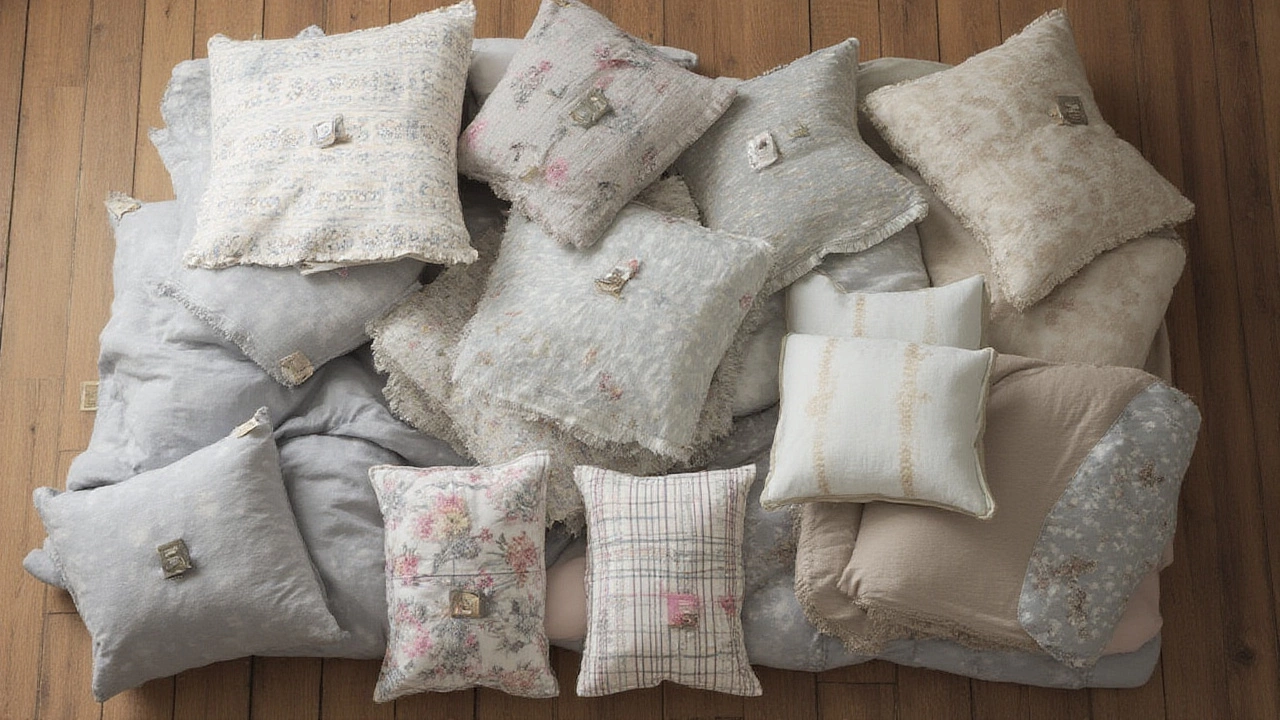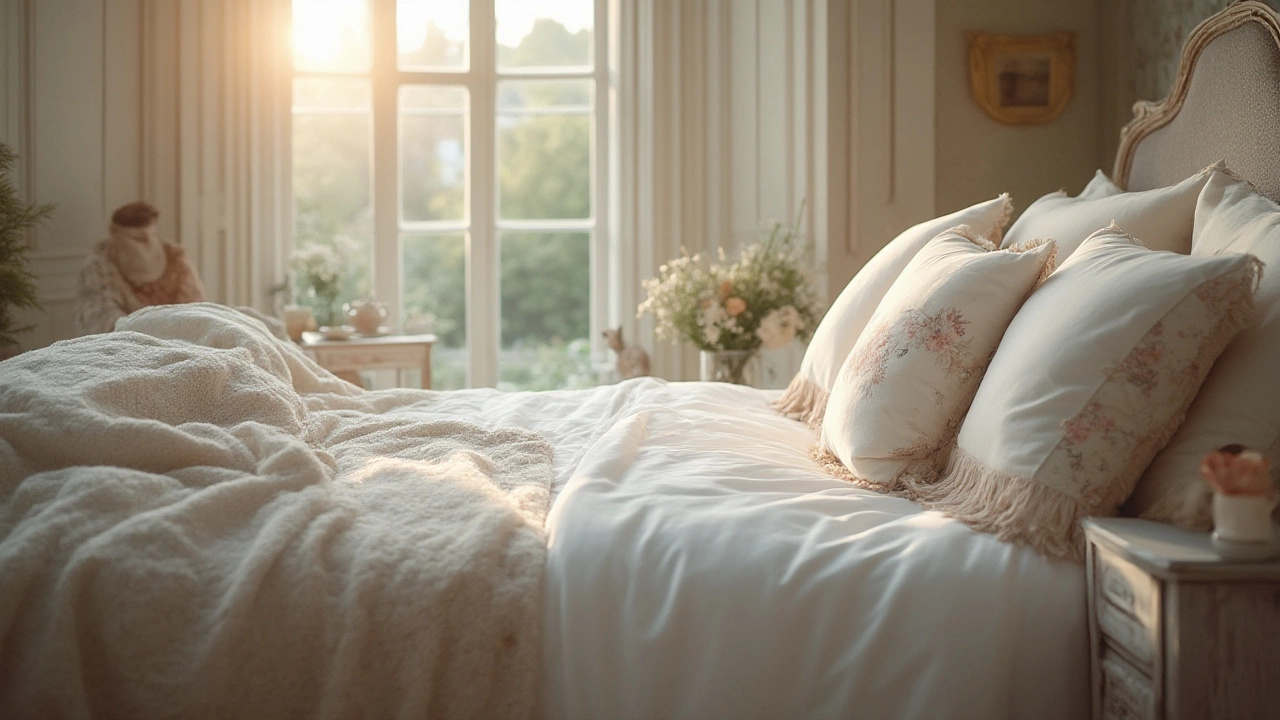Ever stood in the middle of a household store and had a total brain-freeze moment trying to figure out which package says "bed sheets" and which one is "bedding"? You're not alone—so many of us toss around these two terms like they're interchangeable, but they actually mean quite different things. If you've ever bought new sheets and wondered why your comforter cover didn’t come with them (or what the heck a duvet is), you’re in the right place. Let’s clear things up, talk about what’s actually on your bed, and help you build the coziest sleep setup imaginable, without confusion or wasting cash on the wrong items.
Defining Bed Sheets and Bedding: What's on Your Bed?
Let’s get this straight—bed sheets and bedding are not the same thing. Bed sheets are just one part of the *bedding* family. Bed sheets specifically are what you sleep directly on or under: the fitted sheet (that hugs your mattress), the flat sheet (that goes on top of the fitted one), and the occasional pillowcase or two. Bedding, though? That’s the whole package. Bedding includes everything you use to make up your bed, from the sheets all the way out to the comforter, duvet cover, blankets, bedspreads, quilts, shams, and even that decorative throw at the end of the bed.
Now, here’s where it gets a little tricky. In the U.S., most people buy "sheet sets," which usually means one fitted sheet, one flat sheet, and two pillowcases (for a queen or king size bed). But "bedding sets" often include extras like a comforter, pillow shams, and sometimes even a bed skirt. Clarity is key! If you’re just buying bed sheets, don't expect a fluffy comforter to magically appear in the package. In the UK, you’ll often see them called "bed linen"—just a heads-up if you’re shopping online.
It’s kind of wild when you realize bedding goes way back—like, ancient Egypt back—where linen sheets showed wealth and status. Fast forward to today, your bed can still be a status symbol (hello, 1,000-thread-count Egyptian cotton!), but it mostly needs to be comfy, easy to wash, and durable. Knowing exactly what you’re buying can help you avoid those embarrassing moments when a guest pulls back a threadbare sheet or you realize your "set" is missing half of what you need.
The Anatomy of Bedding: Every Layer Explained
Bedding is like a fancy layered cake—each part adds flavor, style, and function. Let’s slice into each layer:
- Bed sheets: These include the fitted and flat sheets. They’re the first line of defense between you and your mattress, keeping things clean and comfortable. Want luxury? Look for long-staple cotton like Egyptian or Pima, known for softness and durability.
- Pillowcases: Match the sheet or mix it up for a splash of style. Some come with fancy finishes or envelope closures to keep pillows snug.
- Pillow shams: These are the decorative covers for your main pillows, often matching the bedding set’s top layers.
- Duvet cover: Not quite a comforter, it’s a removable, washable cover for your duvet insert. Europeans love these for the easy cleaning and endless design swaps.
- Comforter: A thick, fluffy blanket usually filled with down or synthetic fibers, stitched shut (no removable cover here). Sometimes they’re reversible, for a quick bedroom mini-makeover.
- Blankets: Extra warmth for chilly nights. Wool, cotton, fleece, or electric for the perpetually cold.
- Quilt: Lighter than comforters, often made of stitched fabric layers with pretty patterns. They’re super breathable—a Southern U.S. favorite for hot weather.
- Coverlet or bedspread: These go over the top for decoration, not usually for warmth, but perfect for making your bed look photo-ready.
- Throw blanket: The cozy accessory you toss at the end of your bed or grab for Netflix nights. Easy style upgrade, instant warmth.
- Bed skirt or valance: Hides the box spring and gives the bed a "finished" look—plus, it’s a dust-catcher if you store things under the bed (who doesn’t, honestly?).
The magic comes in mixing and matching. Swap a heavy comforter for a quilt in summer. Add a throw when the temperature drops. Use shams for quick color pops. Just don’t overload the bed unless you actually want to spend time putting all those layers back together every morning!

Material Matters: Picking the Right Fabrics
Here’s where folks get tripped up. Material absolutely changes everything about your sleep. It affects how your bed looks, feels, and even smells (yes, some fibers trap more odors). Let’s talk fabric, weave, and what it means for your sheets and bedding:
- Cotton: The gold standard for both bed sheets and bedding. Percale (crisp and cool), sateen (smooth and glossy), flannel (great for winter). Egyptian and Pima are long fibers, so they feel super soft. Organic cotton is pesticide-free.
- Linen: Breathable, moisture-wicking, and naturally textured. It’s ideal for hot sleepers or sweaty summer nights. Linen gets softer with every wash but looks wrinkly—embrace the casual look!
- Microfiber: Synthetic, very affordable, and easy care. It’s soft from the start but can run hot for some people. If you’ve got allergies, look for "hypoallergenic" labels.
- Bamboo: Trendy for being eco-friendly and gentle on sensitive skin. Silky feel, fights odor and bacteria.
- Silk: The ultimate luxury—cool in summer, warm in winter, but definitely high-maintenance. Expect to pay, but it does look stunning.
- Blends: Cotton-poly blends are wrinkle-resistant and budget-friendly. They don’t breathe as well but work for guest beds or busy families.
Thread count gets all the glory, but the weave and quality matter more than just going for the highest number. Weird fact? Some brands inflate thread count by twisting fibers together, so 400, 500, even 800 can feel similar if the fabric quality’s low.
One more thing: when you’re shopping for comforters, watch for fill power and weight. High fill power (think 600 and up) is fluffier and warmer—pick what matches your local climate. Down alternatives are less expensive and better for allergies.
How to Shop Smart: Tips and Tricks for Getting the Best Bed Sheets and Bedding
The world of bedding can feel like a total maze—labels everywhere, confusing names, and wild price ranges. Here’s how to come out a winner:
- Measure your mattress first. Seriously—beds come in twin, full, queen, king, California king, and even more obscure sizes. Pillowtop or deep mattresses need “deep pocket” sheets (usually around 16–22 inches deep).
- Decide what you need. Want to replace just the sheets? Look for sheet sets. Need the whole set-up? Opt for bedding sets, but check exactly what’s inside (not all include the comforter or even pillow shams!).
- Think about comfort and climate. Hot all the time? Choose percale cotton or linen. Always freezing? Go for flannel, sateen, or a high-fill-power comforter.
- Pick patterns to match your space—or your mood. Neutrals go with everything, but bold prints or textures make your bedroom feel fresh and new without repainting the walls.
- Check return policies and reviews. Bedding is super subjective—what’s hot and cozy for one person can be scratchy for another. Reliable brands often have trial periods or satisfaction guarantees—use them!
- Wash before you use. New sheets and bedding have finishes and packaging residue. Washing first makes them softer and gets rid of weird smells.
- Rotate your sheets and bedding sets to prolong life—if you have kids, pets, or breakfast-in-bed habits, you’ll never regret that extra set on laundry day.
- If you’re sensitive to dust or allergens, opt for hypoallergenic bedding and wash regularly. Dust mites love mattresses, and bedding is their favorite playground.
Shopping for bedding online? Zoom in on product photos for stitching quality and actual colors. Read the fine print—sometimes the pretty throw pillows are "sold separately" (annoying, but common). And don’t get sucked into just buying the priciest thing—comfort and durability are what matter.

Making Your Bed Like a Pro: Styling, Caring, and Refreshing Tips
Beds don’t just get made, they get styled. The difference between a "hotel bed" and your typical thrown-together morning look is usually a mix of layering and a little everyday care. Start with crisp, fitted sheets—tug them tight to banish wrinkles. Fold a flat sheet over the comforter for that "magazine-ready" border (hotels love this trick). Fluff your pillow shams and prop them in front of your sleeping pillows—bonus points for arranging throws at the foot of the bed or diagonally for an artsy vibe.
Laundering is where even the finest bedding can go wrong. Use gentle, fragrance-free detergents if you have allergies. Skip high heat—cotton and linen love warm, not hot, water. Always separate whites and colors (if you love those bright white sheets, bleach is a no-go—try baking soda and vinegar instead for natural whitening).
Got wrinkles? If you hate ironing, pull sheets out as soon as the dryer stops and fold right away. Linen’s rumples are chic, but if smoothness is your thing, a quick spritz with water and a stretch on the bed solves a lot. Rotate your bedding with the seasons—cool cotton for summer, heavier or layered for winter. Change pillowcases every few days, especially if you have allergies or acne-prone skin. Pro-tip: sunlight actually kills some bacteria, so hang sheets outside when you can (they’ll smell amazing too!).
Decorating with bedding is the cheapest room update you can make. Swap out just the shams or a throw for a whole new vibe. Try mixing textures—quilted throws over sateen sheets, or a waffle blanket folded at the end of the bed. The trick is to choose a color palette and stick to it (nothing wrong with all-white—just use layers and textures so it never looks flat).
Remember, the best *bedding* is the one you look forward to crawling into. There’s no single "right way"—if you want wild patterns, all grey, or a wild pile of throw pillows, go for it. Your bed is your zone.

